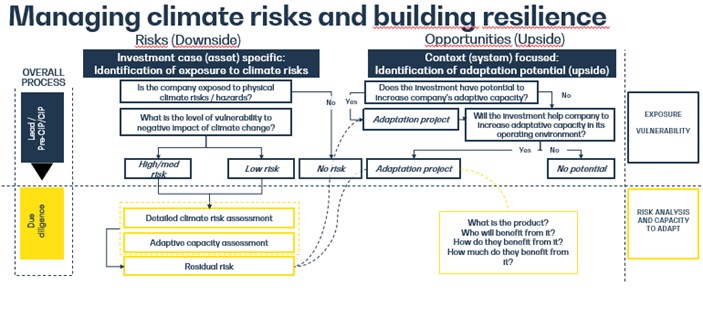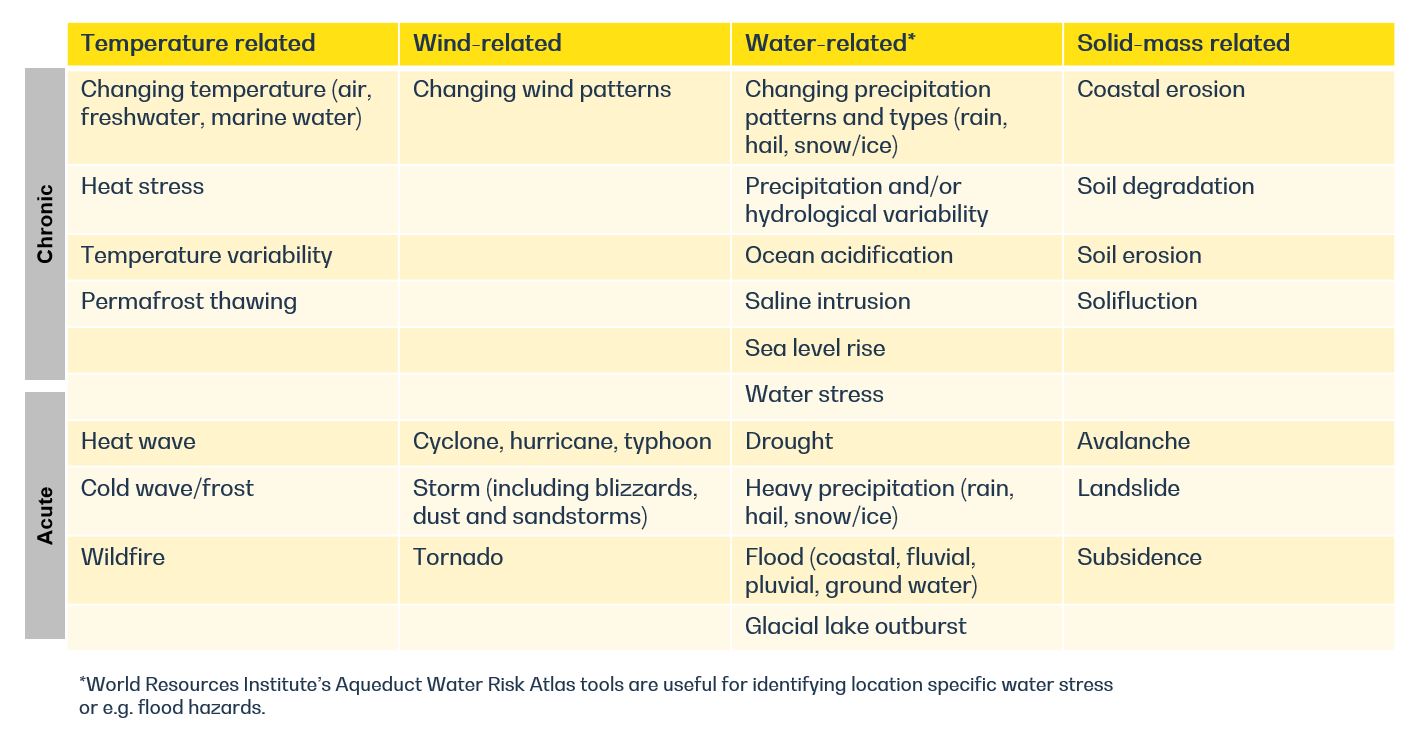Climate risk assessment and identification of adaptation opportunities – our work in practice

Addressing climate change is one of Finnfund’s key objectives. This work is based on our Sustainability Policy, Exclusion list, and Climate and Energy Statement, and builds on identifying physical climate risks and corresponding adaptation opportunities. Through our processes we ultimately aim to increase the climate resilience of our investments.
The intensity and frequency of extreme weather events and chronic climate-related events are increasing globally. These events have an impact on society, communities, and economic activity, with varying magnitudes depending on the sector concerned and its reliance on natural resources. Identifying and understanding climate-related risks and finding solutions to mitigate them and increase resilience is a precondition for businesses’ continued success. It is also an integral part of the assessment and management of financial risks for any company and investor.
As a development financier, we seek to collaborate with our investee companies to identify not only mitigation measures but also business opportunities that climate change adaptation may bring. At a high-level we aim to strengthen also societal resilience in the face of climate change by contributing to systemic transformation.
Every investment is assessed
Many of Finnfund’s priority sectors, such as agriculture, forestry, and renewable energy are highly dependent on natural resources and therefore especially vulnerable to the hazards and chronic risks that climate change imposes on them. Finnfund assesses the climate risks of every investment as part of our investment process. This includes an assessment of both physical climate risks as well as transition risks.

The current process of managing climate risks and building resilience at Finnfund.
A transition risk assessment is completed as part of the due diligence process in the investment proposal preparation phase. It builds on a staged process of risk identification, risk analysis and risk mitigation. The goal is to identify material risks related to policy, technology, market and reputation, which give an initial transition risk rating. Possible risk mitigation measures are then identified. Based on these measures, the final residual transition risk level (high-moderate-low) is determined.
In turn, based on a physical climate assessment, we identify climate-risk mitigation measures, as well as possible climate change adaptation opportunities. Adaptation opportunities are assessed both from the perspective of the underlying business (adaptation of) and in terms of solutions the business may provide to their clients, wider society and / or the economy (adaptation by / through). In some cases, the company’s business idea itself may be in providing adaptation solutions.
This article summarizes and explains step-by-step our current process and methods to identify physical climate risks and adaptation opportunities.
 “The effects of climate change are already tangible in many of our target countries. It is necessary that we assess climate change impacts, as well as the risks, mitigation, and adaptation opportunities for every investment before the investment decision, and monitor the situation throughout the investment life cycle.”
“The effects of climate change are already tangible in many of our target countries. It is necessary that we assess climate change impacts, as well as the risks, mitigation, and adaptation opportunities for every investment before the investment decision, and monitor the situation throughout the investment life cycle.”
– Aleksi Heiskanen, Environmental and Social Adviser
Three phases of assessing climate risks and adaptation opportunities
The assessment is done in three stages:
-
Screening of climate risks and adaptation opportunities
The first step in Finnfund’s investment process is an initial project screening followed by a clearance in principle (CIP) from the Investment Committee to proceed with a more complete assessment of the investment. Physical climate risks and adaptation potential are included in this first screening with an aim to assess an investment’s exposure and vulnerability to climate related risks and hazards.
The identified risks guide us in identifying appropriate measures through which such risks can be mitigated or decreased. In addition, identification of climate risks enables us to build an understanding of the climate change adaptation needs of the investee.
At this stage we therefore also assess the potential contribution that the investment may have to adaptation and climate change resilience, either focusing on the economic activity itself, or looking at the wider business environment and at the system and society levels.
As illustrated in the image below, both acute hazards and chronic changes are included in the physical risk screening, and their relevance to the business is assessed. The investment team’s Environmental and Social Advisor undertakes the physical risk screening. Every investment receives a climate risk rating (high-moderate-low) that guides the next steps of the process. The risk rating is made based on a combination of the location specific risks, sector vulnerability and business vulnerability with regard to those risks.
In turn, the investment team’s Development Impact Advisor assesses potential adaptation opportunities, which also contributes to the development effect scoring of the investment.

Classification of climate-related hazards aligned with the EU taxonomy.
Screening for risks relies on existing databases and data sources such as IPCC, ND Gain and Think Hazard. As part of continuously striving to improve our processes, Finnfund is also assessing new tools and means to undertake climate risks assessments in the CIP phase.
Physical risks are identified with guiding questions such as:
1) Is the company exposed to physical climate risks and hazards?
2) What is the level of vulnerability to the negative impacts of climate change?
Adaptation potential is identified with guiding questions such as:
1) Does the investment have the potential to increase the company’s adaptive capacity?
2) Will the investment help the company to increase adaptive capacity in its operating environment?
In case physical climate risks and/or adaptation potential are identified, a more in-depth analysis will be part of the due diligence process.
In addition, the investment team’s financial analyst assesses the transition risks related to the investment. Depending on the investment and the sector, the key questions to address can be, for instance:
- In terms of sector and / or country or region, what risks or opportunities related to changes in markets or regulation might there be for the company in the future?
- Is there a risk of a ban or restrictions on specific fuels and technologies?
- How significant is the risk of electricity grid uncertainty caused by an increased amount of intermittent renewable power generation capacity?
- Will there be significant raw material cost increases or use restrictions, leading to increased capital expenditures?
-
In-depth climate risk and adaptation opportunity analysis during the due diligence
After CIP approval by the Investment Committee, the investment case enters the due diligence phase.
Any climate risks or adaptation potential identified in the initial screening will be further assessed. The assessment covers the company’s capacity to mitigate the identified climate risks. To build a comprehensive understanding of the risks and adaptation potential, Finnfund’s analysis covers the main supply chains of the economic activity as well as market aspects.
The risks are also assessed through a ‘gender lens’, in other words guiding questions are used to assess whether the risks and vulnerabilities differ between the company’s stakeholder groups, and men and women.
In case the company’s activities increase adaptive capacity and resilience beyond the company’s own activities, Finnfund will specify the adaptation product or service and its benefits, beneficiaries, and the scale of benefits.
In case the due diligence process identifies a need to improve the mitigation and adaptation efforts in the company, they may be included in the Environmental and Social Action Plan (ESAP) or in other contractual documents between Finnfund and the investee company. The identified risk mitigation measures and their impact contribute to a final physical climate risk rating, which Finnfund flags as the investment’s residual climate risk.
Before the investment decision, Finnfund also carries out a credit risk rating process to define different credit risks related to an investment. This process results in a credit risk category for the investment; categories vary from AAA to D. Since 2021, Finnfund has included a consideration of physical and transition climate risks in internal credit risk rating methodology. Based on the outcomes of the climate risk assessment undertaken in the due diligence phase, Finnfund applies standardized metrics as inputs in its credit risk rating.
Example 1: A forestry company plants indigenous tree species in the buffer zones of their plantations as part of their land use and buffer zone planning. In case the region is hit by extreme weather conditions such as an exceptionally heavy storm, these trees can protect the plantation from more serious damage.
Example 2: Droughts linked to climate change amplify the threat of fires in plantation forests. Implementing well designed fire breaks serves as an important mitigation measure. These firebreaks can also be used for small-holder farming purposes, providing agricultural opportunities for local communities. This can be an option as long as crop selection is done correctly, and other necessary measures are taken to maintain the function of the firebreak.
Example 3: Climate change increases the risk of drought and makes weather patterns more unpredictable. While a large part of agricultural production in many developing countries is still rain-fed, agricultural actors also use various irrigation methods. To conserve water and ensure shared access to essential resources, producers can introduce drip irrigation, for example, providing a more regular and measured water supply to agricultural products.
-
Monitoring
After the investment agreement, Finnfund continuously monitors and works with its investee companies. In addition, through an annual reporting process, Finnfund reviews investees’, environmental and social and development impact performance. Climate risk monitoring is included in this process, based on the risk rating and identified climate events which may affect the target country or investment. For example, measures included in the Environmental and Social Action Plan will be monitored annually to ensure compliance. Changes in the risk level of the investment – positive or negative – may also affect the credit risk rating of the investment.
In 2021, Finnfund joined the Adaptation and Resilience Investors Collaborative, a joint initiative of 18 development finance institutions active in adaptation and resilience finance. Part of the work of this initiative includes work on harmonized metrics and indicators for monitoring adaptation impact. Once further progress on these metrics has been made, Finnfund will review its own processes.
Since 2021, Finnfund has also developed its approach to assessing and managing climate-related risks. This approach is aligned with the four pillars of the Task Force on Climate-related Financial Disclosures (TCFD): governance, strategy, risk management, and metrics and targets. Finnfund’s TCFD report is published annually as part of our Annual Report.
More information:
Climate effects
Climate and Energy Statement (pdf)
Annual Report (incl. Climate action – Task Force on Climate-related Financial Disclosures)
Finnfund first development financier to report carbon net-negative investment portfolio
Sustainability Policy
Blog: Aleksi Koskikallio: Cracking the climate risk code in credit risk management
Interested in knowing more about our work in practice?
Climate accounting – our work in practice
Human rights management system – our work in practice
Responsible tax principles in practice – our work in practice
Marko Berglund, Senior Development Impact Adviser, tel. +358 50 433 6458, marko.berglund@finnfund.fi
Aleksi Heiskanen, Environmental and Social Adviser, tel. +358 40 574 1440, aleksi.heiskanen@finnfund.fi
Aleksi Koskikallio, Risk Manager, tel. +358 45 638 1710, aleksi.koskikallio@finnfund.fi